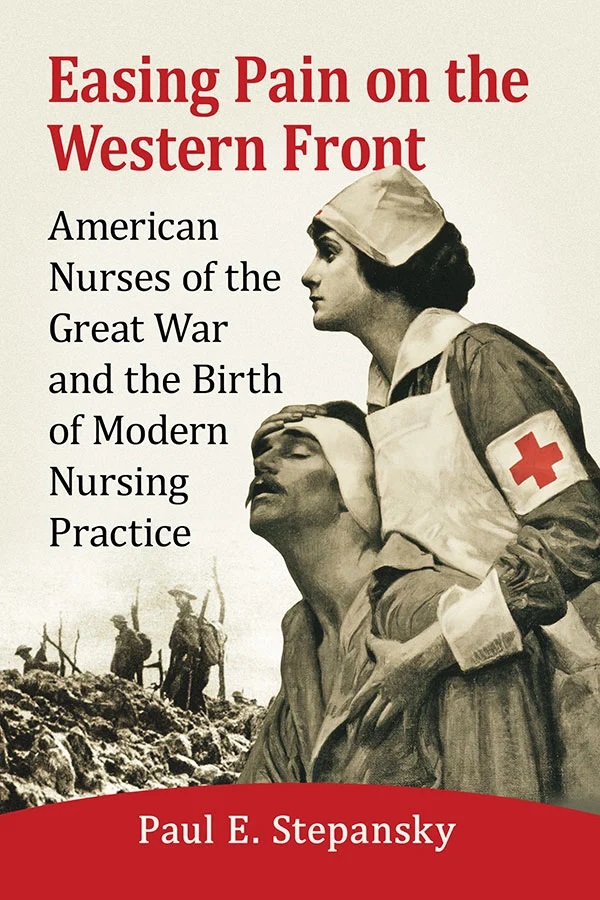Book Review by Dr. Richard M. Prior
Paul Stepansky. Easing Pain on the Western Front. McFarland & Company 2020 (paperback version), 232 pages. ISBN 978-1-4766-9001-9.

Paul Stepansky’s Easing Pain on the Western Front provides a very new and unique insight into the experience of U.S. Army nurses providing direct care on the battlefields of the Western Front in the Great War. In addition to caring for the trauma patients most commonly associated with wartime hospitalization, these nurses faced a nearly endless series of additional challenges that included caring for those who suffered from being gassed, those afflicted with “shell shock,” and thousands of patients ill due to the Spanish Flu pandemic. Throughout the book, Stepansky explains how nursing’s scope of practice expands during wartime, but largely reverts to its previous form afterwards.
The nurses of World War I were women only. As such, they couldn’t be drafted, and had to be recruited and volunteer for service. Stepansky illustrates how these women viewed the prospect of war as an adventure and a character-building experience that quickly transitioned into a struggle to function in an environment with never ending trials. Despite the personal challenges the nurses experienced due to endless streams of horrifically wounded soldiers, long hours, and fatigue, the nurses continued in their mission of providing the highest quality of care and easing the suffering of the afflicted soldiers.
From the onset, Stepansky provides detailed descriptions of how the scope of nursing practice expanded during war, as nurses found themselves engaged in delivering care that was typically associated with physicians. The nurses triaged soldiers in receiving areas, debrided and irrigated wounds in the operating room, and anesthetized surgical patients. In a conflict that pre-dated the use of antibiotics in preventing post-operative surgical site infections, prophylaxis consisted of irrigating wounds with Carrel-Dakins solution, a diluted sodium hypochlorite solution that had some antibacterial properties while being minimally irritating to healthy tissue. The nurses had the primary responsibility of wound care, as they prepared the solution and administered the treatment by slowly dripping it over the wound using special tubing. The nurses “Dakinized” the wounds on the wards for five to seven-day periods and were instrumental in preventing gas gangrene.
The nurses provided care for the soldiers’ psychological wounds as well. Stepansky provides a historical overview of the medical approach to “shell shock” (now referred to as post-traumatic stress) that includes the debate of the time as to whether it was a true condition or a type of malingering. Nurses cared for patients who – compared to those with other disorders – had unusual symptoms such as prolonged staring, becoming easily startled, or suffering from spontaneous emotional outbursts. Stepansky recounts the experiences of the nurses themselves as they too suffered from traumatic stress due to their own repeated exposures to trauma, gore, suffering and death.
An experience that was unique to the nurses of the Great War was the care of patients who were “gassed” with chlorine, mustard, and phosgene chemical weapons that were delivered in canisters and shells along the Western Front. The gas would cause severe burns to exposed skin and inflammation of the upper and lower respiratory systems. The soldiers would experience difficulty breathing and would often expose the nurses who provided their initial care to the gas on that remained on their uniforms. The nurses found the pain, suffering and disfigurement experienced by the gassed patients to be particularly unsettling, traumatic, and senseless. Stepansky recounts how the nurses improvised care as they provided comfort to the disfigured and suffering patients.
As if the task of caring for those wounded in combat was not difficult enough, the nurses of the Great War had the additional burden of caring for those afflicted by the Spanish Influenza pandemic. The wartime conditions of crowded transport ships and training barracks resulted in a U.S. Army that would become incapacitated by the flu, as over one million soldiers contracted the disease. Stepansky illustrates how the nurses – who were already strained by the existing workload – would become ill themselves as they cared for those with the virus. The chief nurses would face the difficult challenge of maintaining staffing levels and morale as their own nurses fell ill, often succumbing to influenza themselves.
Stepansky’s Easing Pain on the Western Front succeeds in educating the reader on the experience of what it was like providing care as an average bedside nurse during the Great War. Stepansky’s comprehensive analysis of nursing care is illustrated with the words of the nurses themselves, who recounted their experiences in letters, diaries and memoirs. Throughout the book, Stepansky expertly compares the experiences of the nurses in previous and subsequent conflicts, allowing the reader to place the Great War nurse in context. Easing Pain on the Western Front is particularly compelling in that it truly illustrates the relationship between nurses and patients and how each party is changed by the experience. It is a unique book that rightfully takes a prominent place among the scholarly histories of healthcare during the Great War.